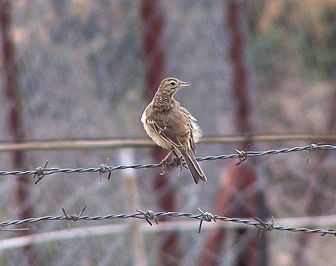Richard's Pipit
It belongs to the pipit genus Anthus in the family Motacillidae. It was formerly lumped together with the Australasian, African, Mountain and Paddyfield Pipits in a single species: Richard's Pipit, Anthus novaeseelandiae. These pipits are now commonly considered to be separate species although the African and Paddyfield Pipits are sometimes treated as part of Anthus richardi.

Original source: Ballet Dancer
Author: Charles Lam from Hong Kong, China
The Richard's Pipit is classified as Least Concern. Does not qualify for a more at risk category. Widespread and abundant taxa are included in this category.
Richard's Pipit in Hong Kong. Conservation status Least Concern (IUCN 3.1) Scientific classification Kingdom: Animalia Phylum: Chordata Class: Aves Order: Passeriformes Family: Motacillidae Genus: Anthus Species: A. More
The Richard's Pipit (Anthus richardi) is a medium-sized passerine bird which breeds in open grasslands in northern Asia. It is a long-distance migrant moving to open lowlands in southern Asia. It is a rare but regular vagrant to western Europe. This bird was named after the French naturalist Monsieur Richard of Lun More
Richard's Pipit, Isles of Scilly, St.Martins 8th May 2002 © robert flood Richard's Pipit - Richard's Pipit, Isles of Scilly, St. More
Richard's Pipit is a well-camoflaged brown ground-dwelling bird. It has darker brown streaks above, and has pale creamy white stripes on the eyebrows and below the cheeks. The underparts are creamy white, spotted and streaked dark on the breast. The wings and tail are dark brown, with the outermost tail feathers white. The eye is brown and the bill and feet are pale pink-grey. Seen on the ground in open country, this species often wags its tail up and down while foraging. More
For the purposes of our bird news services, Richard's Pipit is classed as Scarce: broadly speaking, species that are covered in British Birds' annual review of scarce species (and forms of similar rarity). More
tentative at best, particularly the Richard's Pipit photographed in Thailand in March. I encounter large numbers on the Tonle Sap floodplains in Cambodia on a regular basis, they are both present in numbers here. I find call difficult, as you say, Paddyfield has a range of calls, some explosive, but I find it's one of those things - when you hear a Richard's Pipit, you just 'know' that's a Richard's. Note that Robson (2000) indicates that Richard's Pipit does not occur in Malaysia. More
Richard's Pipit, but is slightly smaller, has shorter legs and a shorter dark bill. It is also less streaked. Its flight is strong and direct, and it gives a characteristic "schip" call, higher pitched than Richard's. More
Richard's Pipit at Kersall September 2008 Initial sighting and circumstances The morning of September 20th 1998 had'nt been anything particularly out of the ordinary. A trickle of migrants ensured that there was enough to keep me busy at Eakring Flash, but that was about all. More
somone had found a Richard's Pipit on Otmoor. As soon as I was able I called him back to find out the details. Apparently it had only been seen by the one person but as he was "Mr. Otmoor", practically living on the reserve and also a birder of huge experience, there was no doubt that the sighting was genuine. More
It is very similar to Richard's Pipit, but is slightly smaller, has shorter legs and a shorter dark bill. It is also less streaked. Its flight is strong and direct, and it gives a characteristic "schip" call, higher pitched than Richard's. In south Asia, in winter some care must be taken to distinguish this from other large pipits which winter or are resident in the area, including Richard's Pipit, Blyth's Pipit and Paddyfield Pipit. Tawny Pipit is insectivorous, like its relatives. More
Richard's Pipit and Paddyfield Pipit of Asia, and the African Pipit of Africa. In addition it has been suggested that the Australian and New Zealand populations be split, or even that New Zealand's subspecies found on its outlying Subantarctic Islands be split from the mainland species. In part the taxonomic difficulties arise due to the extreme similarities in appearance across the genus. Two species have been identified comparatively recently in South Africa, the Long-tailed Pipit in 1996 and the Kimberley Pipit in 2002. More
Anthus richardi / Richard's Pipit / Större piplärka, E of Irkutsk, Russia. Anthus richardi / Richard's Pipit / Större piplärka, Tunkinskey Valley, SW of Lake Baikal, Russia. Anthus richardi / Richard's Pipit / Större piplärka, Tunkinskey Valley, SW of Lake Baikal, Russia. Same as previous. Anthus richardi / Richard's Pipit / Större piplärka, SW Transbaikal, Russia. More
Richard's Pipit ?? Forward | Print | Individual message | Show original | Report this message | Find messages by this author Taken at Sultanpur NP yesterday 7th March 2010 Always thought that the hindclaw would be diagnostic. In this bird I can't quite decide. Call was unlike paddyfield but had white outer tail feathers in flight. Please help Sharad pipit2. More

Original source: J.M.Garg
Author: J.M.Garg
Permission: Some rights reserved
Family : Motacillidae
Genus : Anthus
Species : richardi
Authority : Vieillot, 1818
